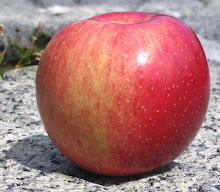
|
Today's apple grew in the same orchard where this variety was first discovered one hundred and fifty years ago.
American Beauty, large, round, and ribbed, has a dark red blush, sometimes streaky, over yellow green. Russet, rough to the touch, gives this fruit a sandblasted aspect. Lenticels are light, on the large side, and numerous.
My apple feels quite firm and smells of cider.
It takes a little effort to bite into the Beauty's dense, juicy flesh, which is medium coarse and the color of light yellow cream.
Her flavor is delicately sweet, with hints of refined sugar; there are some generic floral and (nearly) vinous qualities too. Despite her size and heft, American Beauty is light and delicate.
This variety's size, texture, and delicacy recall those of another antique variety, Opalescent.
Just about anyone who likes fruit would enjoy this apple, though some might prefer it sliced. There are no sharp notes, and her appealing sweetness is not overpowering.
 Sunny Crest Orchards,
in Sterling, Massachusetts, claims to be located on the site of the old
orchard where this apple was found in the 1850s.
Sunny Crest Orchards,
in Sterling, Massachusetts, claims to be located on the site of the old
orchard where this apple was found in the 1850s.
(Sunny Crest's harvest is available to those of us in the greater Boston area at Volante Farms in Needham.)
American Beauty is one of 129 varieties with a ticket to board the Ark of Taste.

I live in the Tamar Valley (Cornwall/Devon border), which, over the centuries, developed hundreds of varieties of apples; sadly, many are lost to history. However, American Mother is grown here and I was told it likely started off as Cornish Mother and went to the New World colonies with the settlers where it got a new name.
ReplyDeleteCotehele Manor, on the river banks, started a "mother orchard" 10 years ago to save the old Tamar varieties, and it has at least 100 local varieties, including American Mother. (https://www.nationaltrust.org.uk/cotehele/features/a-garden-for-all-seasons-at-cotehele) (https://www.theguardian.com/lifeandstyle/2008/nov/04/apples-orchards-national-trust-cotehele)
I am wondering if more older American apple varieties discovered in New England are actually descendants of the Tamar varieties. Plymouth, home of the Mayflower, is at the mouth of the Tamar and it would make sense if some local varieties crossed the Atlantic, too.
I was fortunate to review Mother a few years back. However, the apple in this page is not Mother, but another Massachusetts apple called American beauty.
DeleteHere's American Mother as I found her 3 harvests ago.
BTW, the apples grown here (Tamar Valley) are not just desert apples; many are "cookers" and, of course, this is cider country. In the old days, the flavor of cider was enhanced during fermentation with carcasses of anything available, from sheep to rats. The resulting scrumpy was usually very strong and supposedly quite palatable.
ReplyDeleteI am at 9,000 feet in New Mexico zone 5b with hot days and some cold winter nights but not as bad as 6,500 feet Colorado. I grow Ben Davis, empire, Cortland, snow apples and several others. Would American beauty have anything about it that wouldn't do well at high elevation win some late snow dumps? Does it flower particularly early. I only grow zone 4 or less trees in case we have a cold spell. This is surely a pretty Apple. I'd like to acquire Mother as well if anyone has one.
ReplyDeleteVee, I hope others will jump in if they have advice about growing in the mountains. My tentative guess is if you can grow all those other Northeastern apples, why not this one? I have no leads on Mother, but I've seen Mother scion wood for sale online.
Delete